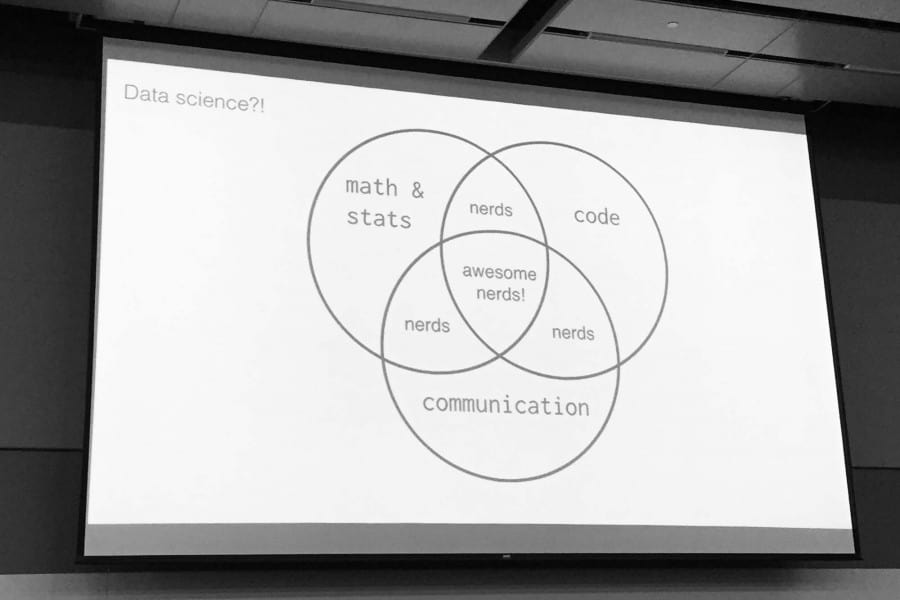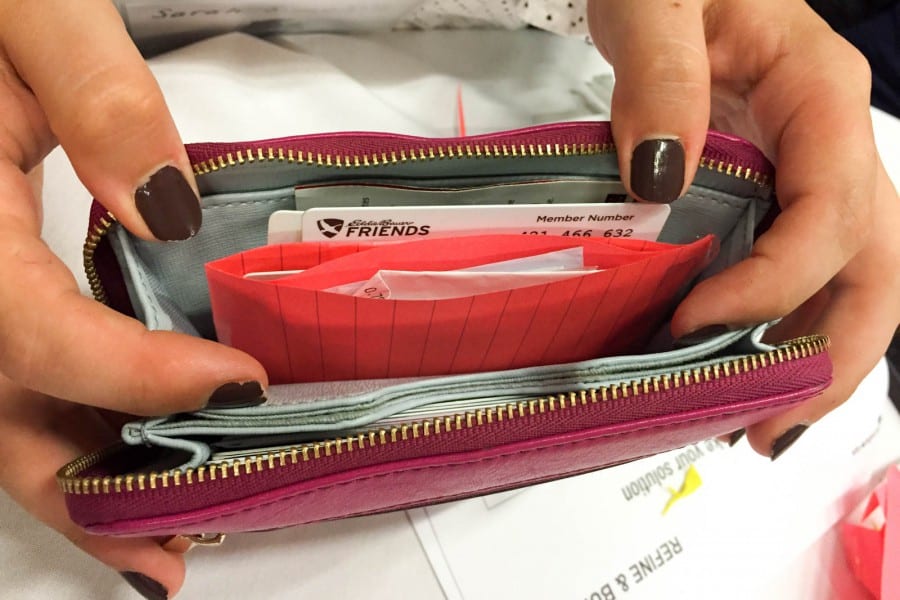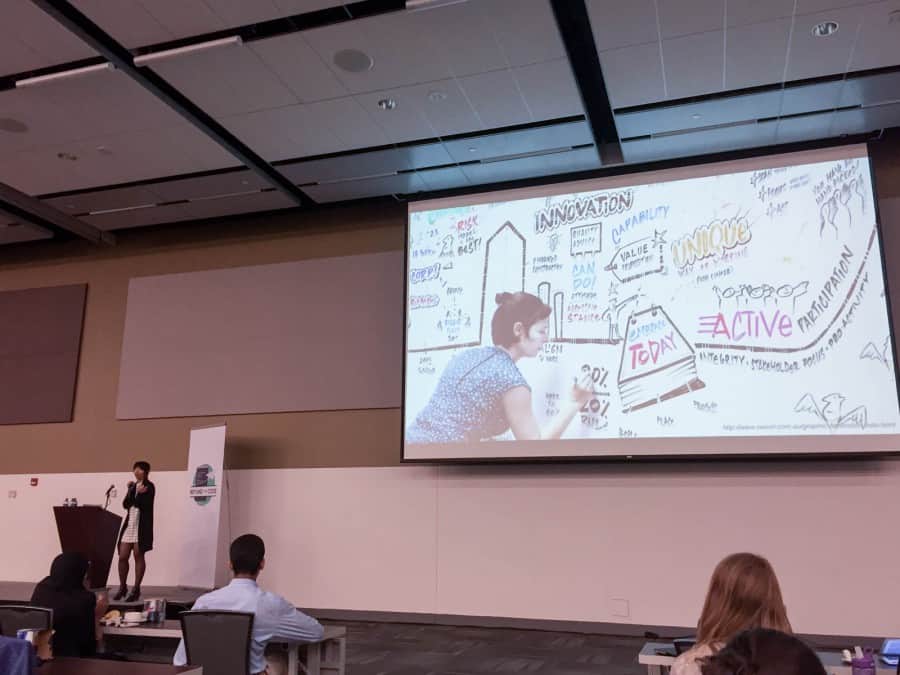Beyond the Code: An Inclusive Tech Conference

Last week, on September 21, 2015, I attended the second annual Beyond the Code conference in Ottawa. Sponsored by Shopify and organized by Bronwyn Kelly and Anna Lambert, the event was inspired by Lambert’s own frustrations at tech conferences.
Two years ago, Anna was frustrated by the lack of women speakers featured at tech conferences. At one conference, she asked the event organizer why they didn’t have any women speakers. The organizer told her that they simply couldn’t find any women. A year later, Anna showed how wrong that event organizer by organizing the first Beyond the Code conference: with an all-female speaker, workshop leader, and panelist line-up.
Before the conference got started, Anna asked for a show of hands of who was was at the first Beyond the Code. So many people raised their hands! I saw lots of familiar faces. It was lovely to catch up with the people I met last year. Elyse Viotto was one of those friendly faces. She created beautiful sketchnotes of every talk.
What Sets Beyond the Code Apart: Inclusivity
The Beyond the Code team put together an event that was accessible, comfortable, and inclusive for people of all backgrounds. Tickets were affordable at $150 for general admission or $75 for students. A delicious, healthy lunch and coffee and tea were provided throughout the day. The best part? Childcare was available for anyone who needed it.
The #btc15 conference in Ottawa GETS IT… There is childcare provided at the conference this year. Now that’s inclusive.
— Krista House (@kristahouse) September 21, 2015
Rather than focus on the latest web development tools or frameworks, the speakers, workshop leaders, and panelists shared their insight from their experiences in the tech industry. Every one of the talks included a little something for everyone. Whether you’re just starting out, you’re curious about the industry, or you’ve been apart of the tech world for decades, there was something of interest for you.
This is another thing #btc15 is doing well: including perspectives from people in tech across different roles and functions.
— Kat Li (@kitchenettekat) September 21, 2015
Summary of Talks, Workshops & the Panel Discussion
- Creative Machines, People, and Organizations – Hilary Mason
- Marketing is not a Four Letter Word – Kelly Shearon
- Teaching Coding – Safia Abdalla
- Drawing as a Way of Thinking – Katrina Bautista
- Onboarding Shopify R&D – Lydia Krupp-Hunter
- Design Thinking Workshop – Barbara Spanton
- Being Awesome – Jen Myers
- Panel Discussion
Unfortunately, I couldn’t be two places at once … so I missed out on a few of the talks. Since I wasn’t there, I couldn’t do a write-up on them. I missed out on Failure and Experimentation by Lauren Long, It takes a village: building diverse teams by Anshula Chowdhury, and Deploying services with Docker and AWS by Kate Heddleston.
Creative Machines, People, and Organizations by Hilary Mason

Hilary Mason, founder and CEO of Fast Forward Labs got the day off to a great start with her keynote talk Creative Machines, People, and Organizations. She divided her talk into three sections: Technology, Organizational Structure, and People. Hilary’s talk highlighted how common data products are (Foursquare, Dark Sky), how they have evolved with technology, and how they can be used for good.
How Data Science Has Evolved
According to Hilary, data scientists need to combine three kinds of skills: math, code, and communication. In the past, a scientist might focus on one area of expertise (such as math or science). Today, data scientists need to be able to write code, solve mathematical problems, and most importantly be able to communicate their findings to their colleagues. Data scientists are responsible for understanding what others need to know, researching their findings, and explaining their findings in a way this understandable and useful to others.
Hilary’s company, Fast Forward Labs focuses on innovation opportunities through data and algorithms. They work with startups, academics, and large organizations.
. @hHilary suggests that communication and empathy are just as important to the field of Data Science as math/stats are #btc15
— Nasreen Rajani (@nrajaa) September 21, 2015
Using Data Science for Good
Hilary’s talk stressed the power of data, research and empathy. ProPublica’s Surgeon Scorecard project is a great example of the power of data science. The searchable database allows Americans to research their surgeon’s data before going under the knife.
Lauren Talbot & New York Ambulance Response Times
From 2011 – 2013, Lauren Talbot was the Chief Programmer with the Mayor’s Office of Data Analytics in New York. She looked at ambulance response times throughout the city, spoke to the Emergency Response personnel and used her findings to calculate the best locations for ambulances to park in between emergency calls. When she spoke to ambulance staff she discovered they had their own reasons for where they parked in between calls: proximity to washrooms, and food. With their feedback she found locations close to washrooms and food that improved their emergency response time. Overall, she reduced ambulance response time by 1 minute in New York City.
Hilary explained by combining data and simply talking to people, Lauren was able to improve lives.
Marketing is not a Four Letter Word by Kelly Shearon
Kelly Shearon is the Vice President of Marketing at Bugsnag. Her talk, Marketing is not a Four Letter Word emphasized the importance of transparency and marketing and engineering teams working together. Kelly shared stories of people assuming she wasn’t technical enough to understand their questions, and encouraged everyone to assume employees of a tech company are technical.
At Bugsnag, every team member takes a turn answering support tickets. Everyone taking a turn in support ensures everyone understands the product and their users. Bugsnag’s marketing materials are hosted on a Github repository available to everyone in the organization. Working in the open means everyone has the opportunity to learn more about marketing initiatives.
“Marketing and engineering work should happen in parallel. It can help with user research and prepping for launch” @kcshearon YES! #btc15
— Kat Drobnjakovic (@KatDrobnjakovic) September 21, 2015
Design Thinking Workshop by Barbara Stanton

Barbara Spanton lead the sold-out Design Thinking workshop. In an hour, she took us through the five stages of design: learn, define, ideate, feedback, and build. Our assignment was to interview our partner on their wallet preferences, and then create a new wallet for them using the art supplies Barbara provided. In just eight minutes, we quizzed the person next to us on their wallet. My partner, Sarah Simpkin asked me: “How satisfied are you with your wallet? Is it too big or too small? How much would you pay for the wallet of your dreams?”
I’m proud to say the wallet prototype I created actually fits in Sarah’s wallet, and she put loyalty cards and receipts into it right away. Creating a wallet out of art supplies may seem a little silly at first, but the steps we took to get there introduced design thinking practices that could be applied to much bigger ideas.
Drawing as a Way of Thinking – Katrina Bautista

Katrina Bautista ‘s talk Drawing as a Way of Thinking illustrated the power of drawing and visualization in meetings. As a designer, it’s more natural for her to sketch her ideas than write traditional notes.
Katrina stressed that drawing is collaborative and you don’t need to be an artist to integrate drawing into your process. Instead of having a designated note taker, she suggested introducing drawing into meetings to bring the team together. This brings the note-taker away from the sidelines and allows them to participate in the meeting. When everyone participates in note-taking, everyone participates in the meeting’s discussion.
There is an inverse relationship between how complete something is and how much collaboration it invites – the ikea affect @katbuilt #btc15
— Kat Drobnjakovic (@KatDrobnjakovic) September 21, 2015
My favourite take-away from Katrina’s talk was how sharing unfinished ideas inspire collaboration. She explained how rough ideas are inherently more open for conversation. People are more comfortable sharing feedback when an idea doesn’t look complete. Once a design appears complete, it becomes more difficult to give feedback. When you share rough ideas early in your process, clients and colleagues feel like they’re a part of the process too.
Teaching Coding – Safia Abdalla
Safia Abdalla is the co-organizer of PyLadies Chicago, a data-scientist and teacher. Her talk focused on teaching coding, and the importance of empathy and humility in teaching.
When Safia is teaching, she asks herself: “What will people want to know when they leave the room?”. She creates a loose curriculum, and then tailors the lesson to her students. Her teaching philosophy emphasizes the importance of paying attention to your audience, and making mistakes.
The most powerful tool in technical teaching is empathy @captainsafia #btc15
— Kat Drobnjakovic (@KatDrobnjakovic) September 21, 2015
Safia told us a story of two years ago when she was in her hometown, in Sudan. She wanted to teach JavaScript to the girls at a local school. Before she proposed this to the school, she sat in on the classes so she could get to know the students and how they learn. After she got to know the students she posted a sign-up form and twenty-four girls signed up to learn JavaScript!
When she taught the class, Safia kept in mind the student’s environment. These students likely wouldn’t have access to a good wifi or computers. It was hot, and when they turned on the fan, the power went out. Safia tailored her lesson to the students’ environment. She taught the class on her own laptop and made sure to share resources they could access.
Onboarding Shopify R&D – Lydia Krupp-Hunter
Shopify’s Lydia Krupp-Hunter shared her insight on internal education and onboarding. Lydia discussed onboarding as an opportunity to educate new and existing employees on company policies. Employees are impressionable in their first few days on the job. A new hire’s first few days on the job are a great time to educate them on key values for your organization.
.@funionnn: Skills, connections and self-sufficiency are 3 key pillars of onboarding #btc15 #Ottawa
— Kuhlabo (@kuhlabo) September 21, 2015
Lydia emphasized the importance of consistent policies for employees, whether the team member works remotely or in-person. Everyone should be able to access the same opportunities and information. People learn differently, and it’s important to teach people to be self-sufficient. Put key company policies in writing and put them somewhere accessible to everyone. Things don’t have to be complicated. When you’re brainstorming how to implement a new tool or idea, why not go with the lowest tech solution possible?
Being Awesome – Jen Myer
Jen Myers‘s talk Being Awesome was well, awesome. Jen is the founder of Girl Develop It, and Director of Open Source Curriculum at Pluralsight. She started her talk by questioning the idea behind “#humblebrag”. Why should we be discouraged to share our accomplishments? Jen used a great example to illustrate that self-deprecation is something we learn as we grow up. Children aren’t ashamed to share their awesomeness:
Eight year old Aubrey Anderson-Emmons, who plays Lily Pritchett on Modern Family, was asked on the red carpet: “How do you memorize your lines? Do you have a trick or are you just that good?” She replied “I’m just that good”.
When Jen shared this story, we all laughed. But why is this funny? Anderson-Emmons hasn’t yet learned we are supposed to diminish our accomplishments – even when someone asks us directly about them.
.@antiheroine: we’re living in a time that teaches us to diminish our accomplishments — how are we then valued for our strengths? #btc15
— Christina Devine (@koolkrys) September 21, 2015
Jen encouraged us to share our accomplishments, and reminded us that you don’t have to be an perfect to be an example for others. You don’t need to know everything to be valuable for others.
Panel Discussion
The conference ended with a fantastic panel discussion moderated by Cate Huston and live-tweeted by Kelly Rusk. The diverse group of panelists (Omosola Odetunde , Lori Olson, Tai Dickerson, Kat Li, Marco Rogers, Brennan Loh) shared their perspectives on the tech industry.
Where are we falling short?
Cate posed questions and the panelists took turns offering their insight. One of Cate’s first questions was “Where are we falling short?”. This prompted a deep discussion of the current issues in the tech industry, and what we can do to improve things.
Age is also an often overlooked diversity issue in tech. No numbers on age diversity–because it’s really, really bad says @wndxlori #btc15
— Kelly Rusk (@krusk) September 21, 2015
There’s a lot of talk about getting more women into the tech industry. But, the number of women in tech is far from the only issue. What about people of colour? What about older people? What about gay or transgender people? What about outside of North America? Increasing the number of women in tech is great, but we’re far from “done”.
Hiring in the Tech Industry
According to the panelists, hiring is only one part of the problem. Marco said that organizations need to turn their attention to retention of their employees. People are human, and hiring diverse groups of people can lead to tension. When that tension happens, who is going to be the first to leave? The marginalized person. Omosola reiterated this, saying that companies should focus on inclusivity and creating environments where employees of all backgrounds feel comfortable.
Bringing diverse people in is not enough-you need to make the effort to make a comfortable space for all. Be aware @omosolatweets #btc15
— Kelly Rusk (@krusk) September 21, 2015
Imposter Syndrome & Internalized Behaviour
Cate co-curates the Technically Speaking newsletter, and people come to her saying they have Imposter Syndrome. Quite often, they’re actually having a perfectly rational reaction to a shitty situation.
Kat, who studied linguistics at Stanford, mentioned how linguistics acknowledges society views men’s behaviour as the default behaviour. Women are criticized for saying “like” or “um” or “just”. What happens when men speak similarly? Nothing.
WOMEN ARE NOT BROKEN. STOP TRYING TO FIX US. – @kitchenettekat #btc15
— Nancy Wood (@nanthelibrarian) September 21, 2015
Tai shared her experiences with internalized behaviour. She interviews others and often feels unqualified because she is a drop-out herself.
Kat re-iterated that people come up with solutions to their own problems. She works with The Last Mile, an organization that educates prisoners at San Quentin Prison and provides them with training to be successful when they leave prison. In The Last Mile’s program, one inmate’s idea was to re-distribute misshapen vegetables to feed the hungry across America.
Links & Resources
- Kelly Shearon’s slides – Marketing is not a Four Letter Word
- Katrina Bautista’s notes from her talk – Drawing as a Way of Thinking
- Cate Huston’s collection of tweets from the panel
- Gail Carmichael’s write-up of Beyond the Code
- Lauren Talbot – Every Second Counts – Measuring 911 End-to-End Response Times in NYC
Beyond the Code – Next Year?
The second annual Beyond the Code was even better than last year. Anna and Bronwyn are planning a third Beyond the Code for next year! Nothing’s official yet, but Anna told me the conference may move to Toronto next year. I can’t wait!
Pingback: Reflections on 2015 and goals for 2016
Pingback: Shopify hosting Beyond The Code to encourage inclusivity in tech | BetaKit